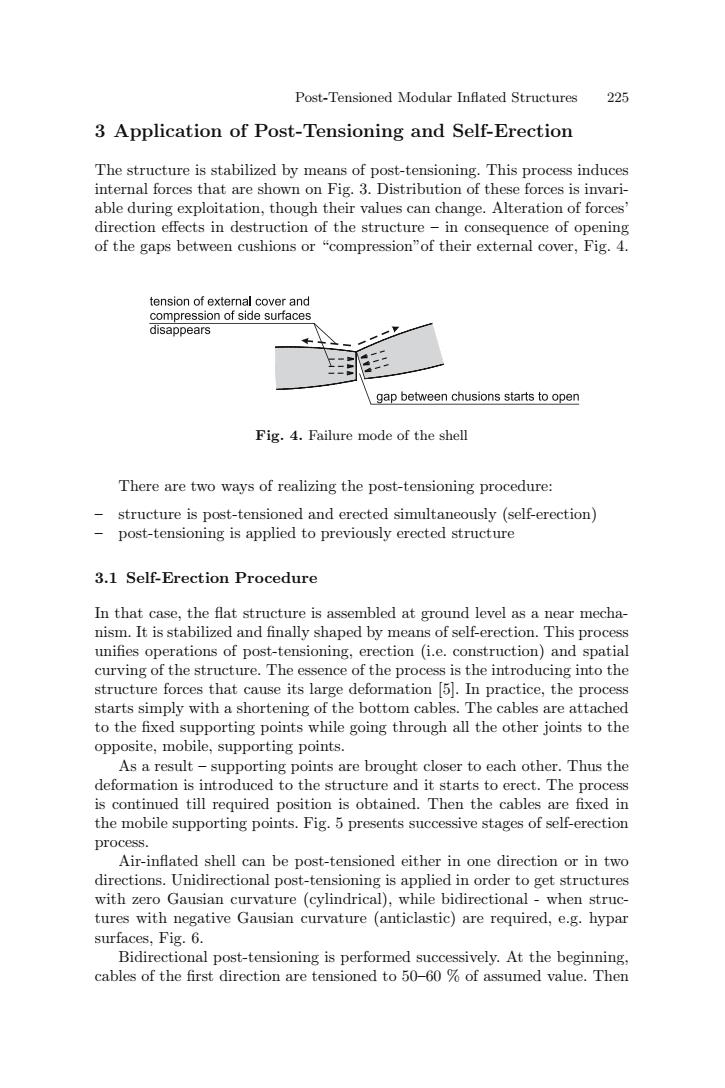正在加载图片...

Post-Tensioned Modular Inflated Structures 225 3 Application of Post-Tensioning and Self-Erection The structure is stabilized by means of post-tensioning.This process induces internal forces that are shown on Fig.3.Distribution of these forces is invari- able during exploitation,though their values can change.Alteration of forces' direction effects in destruction of the structure -in consequence of opening of the gaps between cushions or "compression"of their external cover,Fig.4. tension of external cover and compression of side surfaces disappears gap between chusions starts to open Fig.4.Failure mode of the shell There are two ways of realizing the post-tensioning procedure: structure is post-tensioned and erected simultaneously (self-erection) post-tensioning is applied to previously erected structure 3.1 Self-Erection Procedure In that case,the flat structure is assembled at ground level as a near mecha- nism.It is stabilized and finally shaped by means of self-erection.This process unifies operations of post-tensioning,erection (i.e.construction)and spatial curving of the structure.The essence of the process is the introducing into the structure forces that cause its large deformation [5].In practice,the process starts simply with a shortening of the bottom cables.The cables are attached to the fixed supporting points while going through all the other joints to the opposite,mobile,supporting points. As a result-supporting points are brought closer to each other.Thus the deformation is introduced to the structure and it starts to erect.The process is continued till required position is obtained.Then the cables are fixed in the mobile supporting points.Fig.5 presents successive stages of self-erection process. Air-inflated shell can be post-tensioned either in one direction or in two directions.Unidirectional post-tensioning is applied in order to get structures with zero Gausian curvature (cylindrical),while bidirectional-when struc- tures with negative Gausian curvature (anticlastic)are required,e.g.hypar surfaces,Fig.6. Bidirectional post-tensioning is performed successively.At the beginning, cables of the first direction are tensioned to 50-60 of assumed value.ThenPost-Tensioned Modular Inflated Structures 225 3 Application of Post-Tensioning and Self-Erection The structure is stabilized by means of post-tensioning. This process induces internal forces that are shown on Fig. 3. Distribution of these forces is invariable during exploitation, though their values can change. Alteration of forces’ direction effects in destruction of the structure – in consequence of opening of the gaps between cushions or “compression”of their external cover, Fig. 4. Fig. 4. Failure mode of the shell There are two ways of realizing the post-tensioning procedure: – structure is post-tensioned and erected simultaneously (self-erection) – post-tensioning is applied to previously erected structure 3.1 Self-Erection Procedure In that case, the flat structure is assembled at ground level as a near mechanism. It is stabilized and finally shaped by means of self-erection. This process unifies operations of post-tensioning, erection (i.e. construction) and spatial curving of the structure. The essence of the process is the introducing into the structure forces that cause its large deformation [5]. In practice, the process starts simply with a shortening of the bottom cables. The cables are attached to the fixed supporting points while going through all the other joints to the opposite, mobile, supporting points. As a result – supporting points are brought closer to each other. Thus the deformation is introduced to the structure and it starts to erect. The process is continued till required position is obtained. Then the cables are fixed in the mobile supporting points. Fig. 5 presents successive stages of self-erection process. Air-inflated shell can be post-tensioned either in one direction or in two directions. Unidirectional post-tensioning is applied in order to get structures with zero Gausian curvature (cylindrical), while bidirectional - when structures with negative Gausian curvature (anticlastic) are required, e.g. hypar surfaces, Fig. 6. Bidirectional post-tensioning is performed successively. At the beginning, cables of the first direction are tensioned to 50–60 % of assumed value. Then